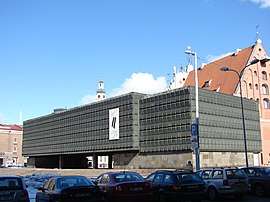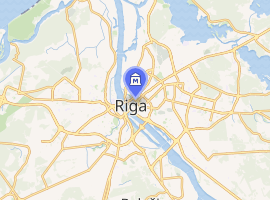Museum of the Occupation of Latvia
The Museum of the Occupation of Latvia (Latvian: Latvijas Okupācijas muzejs) is a museum and historic educational institution located in Riga, Latvia. It was established in 1993 to exhibit artifacts, archive documents, and educate the public about the 51-year period in the 20th century when Latvia was successively occupied by the USSR in 1940–1941, then by Nazi Germany in 1941–1944, and then again by the USSR in 1944–1991.[1] Official programs for visits to Latvia of top level representatives of other countries normally include a visit to the Museum of the Occupation.[2]
Latvijas Okupācijas muzejs | |
 Museum of the Occupation main building | |

| |
| Established | 1993 |
|---|---|
| Location | Raiņa bulvāris 7, Rīga, Latvia (temporary location) Latviešu strēlnieku laukums 1, Rīga (main, under renovation) |
| Type | History museum, Memorial museum |
| Collection size | 60,000 |
| Director | Solvita Vība |
| Owner | Occupation Museum Association |
| Website | www |
History
The museum was established in 1993 after Paulis Lazda, a History Professor at the University of Wisconsin–Eau Claire, proposed the idea to the Ministry of Culture of the Republic of Latvia to create a museum covering the occupation period of Latvia, from 1940 to 1991. This led to the establishment of the Occupation Museum Foundation (OMF), now the Occupation Museum Association (OMB), in spring 1993. The OMF was made of 11 people who aimed to establish, administer and finance the museum.
The first exhibition of the museum opened on 1 July 1993. The exhibition covered the period of the first Soviet occupation of Latvia from 1940 to 1941. The museum was expanded in the following years to cover the whole occupation period.[3]
Mission
The museum's stated mission is to:
- "Show what happened in Latvia, its land and people under two occupying totalitarian regimes from 1940 to 1991;
- "Remind the world of the crimes committed by foreign powers against the state and people of Latvia;
- "Remember the victims of the occupation: those who perished, were persecuted, forcefully deported or fled the terror of the occupation regimes.[2]
The Museum Collection
When the museum was established it began to collect objects relating to the occupation periods. The collection, as of the beginning of 2017, contained nearly 60,000 registered items. The collection also includes an audiovisual archive containing more than 2,300 video testimonials of deportees, refugees, and others affected by the occupations of Latvia. The audiovisual department has also made 10 documentary films.[2]
Building
The main museum building was built by the Soviets in 1971 to celebrate what would have been the 100th birthday of Lenin, and until 1991 it served as a museum commemorating the Red Latvian Riflemen. The planned renovation of the building, which began in the summer of 2018 after years of planning and negotiations,[4] means that since November 2012[5] the museum is temporarily housed in Raiņa bulvāris 7 (Rainis Boulevard), the site of the former US Embassy, nearby the Freedom Monument.[6][7] It is planned that the renovated museum building, dubbed "House For the Future" by the Latvian-American architect Gunnar Birkerts, will be completed in 2020.[8]
See also
- Soviet Occupation Day, Latvia
- Museum of Occupations in Tallinn, Estonia
References
- "Permanent exhibition". The Museum of the Occupation of Latvia (in Latvian). Retrieved 17 March 2018.
- "About us". The Museum of the Occupation of Latvia (in Latvian). Retrieved 17 March 2018.
- "Par muzeju". Latvijas Okupācijas muzejs (in Latvian). Retrieved 17 March 2018.
- "Clashes over rebuilding key Old Riga museum". Public Broadcasting of Latvia. July 3, 2015. Retrieved 2018-09-26.
- "Okupācijas muzejs uz laiku pārceļas" (in Latvian). Latvijas Sabiedriskais medijs. Retrieved 2018-09-26.
- "Getting here". Museum of the Occupation of Latvia 1940-1991. Retrieved 24 February 2017.
- "Okupācijas muzejs pārceļas". Pilseta24.lv (in Latvian). 2012-10-26. Retrieved 2018-09-26.
- "Okupācijas muzeja «Nākotnes nams» durvis vērs ne agrāk kā 2020.gadā" (in Latvian). Latvijas Sabiedriskais medijs. Retrieved 2018-09-26.
External links
| Wikimedia Commons has media related to Museum of the Occupation of Latvia. |